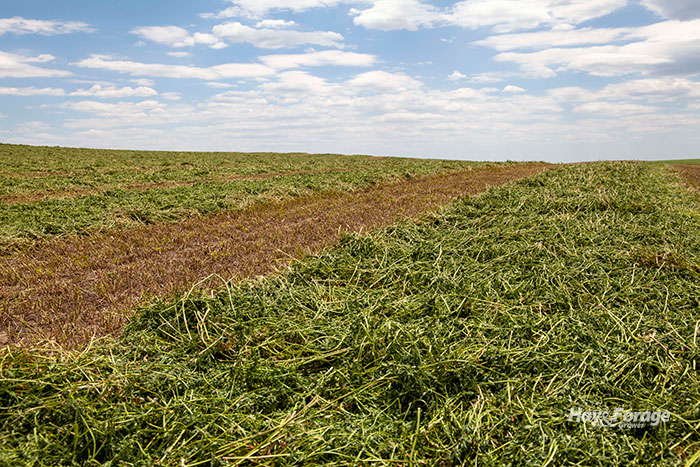
Let’s face it, there are lots of keys to making high-quality forage, but few are more important than a fast dry down. Other than drying, only bad things happen to a forage crop between cutting and baling or chopping. The only way to minimize the pain is to shorten the wilting time.
In a recent issue of the Maryland Milk Moos newsletter, Amanda Grev, extension forage specialist with the University of Maryland, notes that standing forage is about 75% to 80% moisture. That means that between cutting and baling, over 1,200 pounds of water needs to be driven out of a ton of freshly cut forage to get it to optimum baling moisture.
“During this wilting and drying process, plants continue the natural process of respiration, breaking down stored sugars to create energy and carbon dioxide,” Grev explains. “The longer it takes the forage to dry, the longer the forage continues to respire in the field.”
Limiting respiration time saves both dry matter and forage quality. It’s a win-win or a lose-lose proposition depending on drying speed.
Three phases
Grev notes that drying occurs in three distinct phases. Phase 1 involves moisture loss from the leaves.
“This happens through the stomata, which are the openings in the leaf surface that allow for moisture and gas exchange between the leaf and the outside air,” Grev writes. “These stomata are naturally open in daylight and closed in darkness. After a plant is cut, respiration continues but gradually declines until the moisture content has fallen below 60%.”
Rapid drying during this initial phase to lose the first 15 to 20 percentage units of moisture will greatly reduce the loss of starch and sugar, thereby preserving more dry matter and total digestible nutrients in the harvested forage.
To optimize dry-down time during this first phase, exposing the crop to solar radiation is essential. This is best accomplished by laying the crop into a wide swath, at least 70% of the cutting width.
“A wider swath will increase the swath temperature, reduce the swath humidity, and keep the stomata open to allow for moisture loss, encouraging rapid and more even drying immediately after cutting,” Grev explains.
It’s during this initial phase that a wide swath is more important than conditioning because most of the respiration takes place in the leaves. “While conditioning is important for drying stems, it has less impact on drying leaves and therefore will have little effect on this initial moisture loss,” Grev notes.
Phase 2
The next phase of moisture loss involves both leaves and stems. Once plant respiration ceases and leaf stomates close, moisture becomes trapped in the plant. Grev indicates that this is the phase where conditioning the forage is a benefit to speed drying. For alfalfa, a roller type conditioner is preferred to avoid leaf loss.
Phase 3
The final phase is the removal of moisture that is more tightly held, especially in the stems. “Stems generally have a lower surface to volume ratio, fewer stomata, and a semi-impervious waxy cuticle that minimizes water loss, so conditioning is critical to enhance drying during this phase,” Grev explains.
Still more to do
In addition to using wide swaths and a conditioner, the forage specialist offers several other factors that can help speed drying. These include:
• Cut alfalfa at a 2- to 3-inch height and cool-season grasses at 4 inches. This will elevate the cut forage off the ground, which improves airflow. Agronomically, a higher cutting height also enhances regrowth rate and stand persistence.
• Mow during the mid- to late morning after the dew has dried off. This allows the forage to dry down and cease respiration before nightfall on the first day.
• Ted and rake forage when moisture levels are still high enough to avoid leaf loss and preserve forage quality. Ensure that tines are not touching the ground to avoid soil contamination in the forage.
As all forage producers know, there will be times when Mother Nature just doesn’t cooperate between cutting and chopping or baling. It’s a part of the business we just have to accept. Nevertheless, doing all that is possible to speed drying will go a long way toward the ultimate goal of producing high-quality forage. So, with apologies to Larry the Cable Guy, “Let’s Get-R-Dry.”

